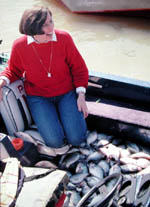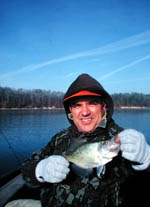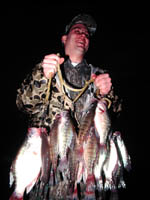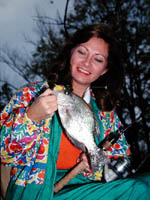
|
Features
|
|
|
|
Books
|
|
|
|
Fun & Games
|
|
|
|
Contact Us
|
|
|
John's Journal... Entry 184, Day 4
HOW TO CATCH PRE-SPAWN CRAPPIE
Planted Crappie
 EDITOR'S
NOTE: Some of the biggest crappie of the year are
caught just prior to the spawn, because not only are the female crappie
full of roe but often they are still carrying their winter weights. Since
pre-spawn crappie can be in various places at different times of the year
in reservoirs throughout the country, any writer who tells you exactly
where to look for pre-spawn crappie more than likely is talking about
where to search for them on the lakes and rivers he knows. Here are some
examples of where and how I have found pre-spawn crappie in the past,
and where you may search for them at this time of year.
EDITOR'S
NOTE: Some of the biggest crappie of the year are
caught just prior to the spawn, because not only are the female crappie
full of roe but often they are still carrying their winter weights. Since
pre-spawn crappie can be in various places at different times of the year
in reservoirs throughout the country, any writer who tells you exactly
where to look for pre-spawn crappie more than likely is talking about
where to search for them on the lakes and rivers he knows. Here are some
examples of where and how I have found pre-spawn crappie in the past,
and where you may search for them at this time of year.
One of the best ways I know to ensure good catches of pre-spawn crappie is to plant for them. By that I mean sink brush or stake beds halfway between the creek channels and the creekbanks. If anglers provide some type of cover for the crappie to hold on when the fish are migrating from the creek channel to the shallow water, the chances are the fishermen will be able to return to that cover within a day or two and take crappie. Sinking cover between the bank and the creek channel not only pays off during the pre-spawn period, but anglers also can catch crappie during the spawn and after the spawn on this same cover. Once the crappie start to spawn, there always will be crappie holding on that mid-water cover waiting to go to the bank and waiting to move back into deep water. Even after the spawn, the crappie will hold on the brush planted between the creek channel and the bank until the water temperature warms up enough to drive them back to the creek channels and river channels. Therefore, if you want to make sure you harvest a crop of crappie before, during and just after the spawn, plant cover under the water now.
"Come on down to my restaurant, John, about l:00 p.m.," Danny Wiles of Birmingham, Alabama, told me. "I've been fishing, and I've caught a big mess of slab crappie." I'd always known Wiles was a good fisherman, because he consistently caught large crappie and spotted bass in tailrace areas. But until I talked with Wiles on this particular day, I hadn't realized he also was insane. Our part of the country had had the worst floods in the history of the state for the two days prior to his phone call. The rivers were about to flow out of their banks all over our state, and I knew the spillways below the dams where Wiles fished had to be open and running water. No one in his right mind would have gone fishing the day Wiles went in the wind, rain and muddy water conditions. But at lunchtime when I sat down to drag some tasty, fried, crappie fillets through a puddle of ketchup, I started picking Wiles' brain about how to catch bad weather papermouths.
 "I
only seriously crappie fish for about three to four weeks during the early
spring prior to the spawn," Wiles said. "I've found the best crappie fishing
to be on the worst days imaginable for several reasons. When the weather's
bad, lots of water is coming over the spillways at the dams, the wind's
blowing, the current in the river is strong, and the water is muddy, rarely
will there be another boat below the dam except mine. Therefore I don't
have any competition for the fish. Also I like to fish on those kinds
of days because the current forces the baitfish into eddy holes and pockets
downriver behind rocks, below underwater drop-offs and behind trees that
have fallen into the river. During these flood water conditions, the baitfish
will school up in these eddy holes, and the big crappie will stack up
in these same areas while gorging on shad in preparation for the spawn.
Usually I can catch all the crappie I want to take in a half-day's fishing.
If I have a limit of 35 fish, I'll generally have five to l0 crappie that
will weigh two pounds or more."
"I
only seriously crappie fish for about three to four weeks during the early
spring prior to the spawn," Wiles said. "I've found the best crappie fishing
to be on the worst days imaginable for several reasons. When the weather's
bad, lots of water is coming over the spillways at the dams, the wind's
blowing, the current in the river is strong, and the water is muddy, rarely
will there be another boat below the dam except mine. Therefore I don't
have any competition for the fish. Also I like to fish on those kinds
of days because the current forces the baitfish into eddy holes and pockets
downriver behind rocks, below underwater drop-offs and behind trees that
have fallen into the river. During these flood water conditions, the baitfish
will school up in these eddy holes, and the big crappie will stack up
in these same areas while gorging on shad in preparation for the spawn.
Usually I can catch all the crappie I want to take in a half-day's fishing.
If I have a limit of 35 fish, I'll generally have five to l0 crappie that
will weigh two pounds or more."
 Wiles
has found one of the best-kept secrets for successful pre-spawn crappie
fishing. He fishes at a time and in a place when most other anglers are
convinced that fishing will not be productive. However, Wiles has learned
that the most productive crappie fishing of the year and when he catches
the biggest crappie is when the rivers are flooding, and the weather is
too rough for weekend anglers. A few years ago, I had planned a day off
to bank fish for papermouths on a small stream near my home. As luck would
have it, the weather turned off foul two days prior to my trip. The rain
came down all night long, just before my off-day. At first light, the
sky was still gray and threatening a shower. But I was off from work,
I had a bucket of minnows, a rod, a box of hooks and a few shot leads,
and I was determined to go fishing. Walking down the bank, I stopped at
every point where I saw an eddy hole. All day long, I consistently took
crappie in the high water with the fast current. For some reason, those
flooding conditions seemed to cause the crappie to go on a feeding spree.
All I had to do to catch them was find the slack water areas where the
fish could hold out of the current and feed.
Wiles
has found one of the best-kept secrets for successful pre-spawn crappie
fishing. He fishes at a time and in a place when most other anglers are
convinced that fishing will not be productive. However, Wiles has learned
that the most productive crappie fishing of the year and when he catches
the biggest crappie is when the rivers are flooding, and the weather is
too rough for weekend anglers. A few years ago, I had planned a day off
to bank fish for papermouths on a small stream near my home. As luck would
have it, the weather turned off foul two days prior to my trip. The rain
came down all night long, just before my off-day. At first light, the
sky was still gray and threatening a shower. But I was off from work,
I had a bucket of minnows, a rod, a box of hooks and a few shot leads,
and I was determined to go fishing. Walking down the bank, I stopped at
every point where I saw an eddy hole. All day long, I consistently took
crappie in the high water with the fast current. For some reason, those
flooding conditions seemed to cause the crappie to go on a feeding spree.
All I had to do to catch them was find the slack water areas where the
fish could hold out of the current and feed.
But swift current and fast-moving streams are not the only places where anglers can catch high water crappie. When the spring floods come, and many rivers and lakes back up into woodlots and fields, often the crappie will follow the moving water into the newly inundated lands. I fish along a flood plain on the Tennessee/Tombigbee Waterway. Using a flat-bottomed johnboat, I go to the river when the water's up and have made some large catches in freshly flooded woodlots during the early part of the spring.
To learn more about crappie fishing, you can contact Jackie Thompson at the Lake Eufaula Guide Service, (334) 687-9595 or e-mail them at info@ledgebuster.com.
TOMORROW: SHALLOW-WATER CRAPPIE
Check back each day this week for more about HOW TO CATCH PRE-SPAWN CRAPPIE ...
Day 1 - Discharge Crappie
Day 2 - Stump Crappie
Day 3 - Feeder Creek Crappie
Day 4 - Planted Crappie
Day 5 - Shallow-Water Crappie
